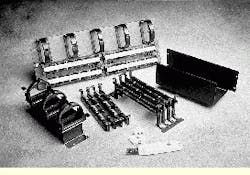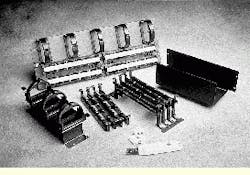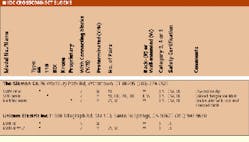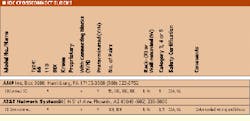Barbara E. Thompson
In the main crossconnect, insulation displacement contact, or IDC, blocks are used to terminate horizontal wiring for voice and data applications. Although all of these systems may look different, they provide the same termination function.
Installers use a punchdown or impact tool to insert the wires into the terminals on the crossconnect block using a method of insulation displacement to establish the electrical connection. The process of punching down the cable refers to the physical force required to penetrate or remove the wire insulation by the contact as the electrical connection is made. The cables are terminated on each punchdown block and separate jumper cables link the punchdown blocks. As needs change, you can vary the jumpers to change the interconnections.
"The 110 block provides high density," says Tom Rider, sales manager, Computer Cable Co. (Bow, NH). "Some of our customers have standardized on 110 blocks in the intermediate crossconnect because they have limited space in the closet and would not have enough room for patch panels. The installers bring the cable to 110 blocks in the closet, maintaining flexibility to configure ports," he says.
Field-termination blocks
Several types of crossconnect blocks are in use today, including the 66, 110 and proprietary systems such as BIX, Krone and Katt. Installers generally use only one type of crossconnect block for each medium type installed in the building. A mixed-block architecture can be difficult to integrate and may also add to maintenance costs for tools and training.
"To some degree, the choice is customer-driven," says Rider. "[Customers] already have a specification for a particular manufacturer`s product and request that we use that type of block. In a structured cabling system with multiple Category 5 cables supporting voice and data service to each location, however, it is usually a 110 crossconnect system."
The "telco" 66 block
For the last 30 years, the 66 block--also known as the telco block--has been the major type of crossconnect used in telephony systems. Developed as the basic crossconnect system supporting traditional analog-voice applications, the 66 block is still installed in many buildings today.
A 66 block--of which there are several variations--comprises a series of dual metal pressure displacement units arranged in two vertical columns of 50 units each. Typically, you can terminate only 50 twisted-pair cables on one standard 66 block. It does not have the higher density of connects as today`s IDC crossconnect blocks. But, over the years, manufacturers have enhanced the 66 block with the integration of some type of twisted-pair connector, such as an RJ-45 jack. This enhancement may be used for data network installations where you can use patch cables to make frequent system changes.
The 66 block is not vendor-specific and is therefore readily available from several sources. Also, because it has been around for some time, most installers are familiar with, and can easily field-terminate, the cable. However, wiring a 66 block with Category 5 unshielded twisted-pair cable requires a different termination method not typically used with voice-grade cables (see "Wiring a Category 5 66 block," September 1995, page 45).
110 blocks
In the 1970s, Western Electric (now AT&T) developed the 110 connecting block, which provided a higher-density crossconnect field than the 66 block. "A 110 block-based crossconnect system is also higher density than a patch panel system, and it is protocol-independent," says Brian Reed, crossconnect product manager at Mod-Tap, a subsidiary of Molex Inc. (Lisle, IL).
These products are sometimes specified by the consultant; or in many instances, the installer is an authorized representative of a particular manufacturer and will choose that product. Jim Alger, vice president at EJ Communications Systems (Long Island City, NY) considers that "the AT&T 110 block is the de facto standard for high-density field terminations."
The 110 block typically consists of four rows of cutting displacement connectors. Mounted horizontally, it can support 25 twisted-pairs per row for a total of 100 twisted-pairs per unit. As in the 66 block, the 110 IDC block can be terminated to a patch panel; that is, a 110 backplane to an interface of RJ-45 jacks.
"Many customers don`t specify block-based systems," says Reed, "simply because they want the convenience of RJ-45 patch cords used with patch panels. Patch cords are available for block-based systems; however, they are more expensive than RJ-45 patch cords and, once you start populating the block with these patch cords, you begin to overrun the cost originally realized by going with a block-based system.
"We recommend using block-based systems as `patch-by-exception` systems. In other words, you initially hard-wire a block-based crossconnect system, then use patch cords when you make moves and changes. Every six months to a year, remove all the patch cords and hard-wire the system again," he explains. This minimizes the cost to install and maintain the system."
The 66 and 110 are common types of IDC crossconnect blocks in the United States, but other proprietary types have become popular as well; for example, the BIX, Krone and Katt systems.
Proprietary crossconnect systems
The BIX block is an IDC crossconnect block designed by Northern Telecom. It uses a cutting displacement method and a removable two-sided block that connects distribution cables on one side to crossconnect wires on the other side. Like other IDC systems, the configuration is horizontal and space is provided behind the unit to allow cables to pass through.
"The BIX IDC block has a double-sided clip in a plastic housing," says Stephane Bourgeois, product manager for connecting hardware at Northern Telecom. "The clips are recessed to avoid direct contact with the copper conductor and prevent accidental disconnects."
This crossconnect system comes with a BIX insertion (not impact) tool for inserting and cutting the wire. "Because of the offset clip arrangement, the BIX IDC crossconnect system exceeds Category 5 standards," says Paul Chalifour, communications manager, Northern Telecom.
Another proprietary system is the Krone type, first developed in Germany and used throughout Europe before coming to the United States. The Krone provides the same function as other IDC crossconnect blocks. The difference is that it has a patented silver-plated contact that sits at a 45-degree angle. "The combination of axial and torsional restoring forces maintains a gas-tight connection and minimizes contact resistance," says David Yanish, product manager for IDC and modular products at Krone Inc.
The Krone system comes in three versions, all with built-in connecting clips. "You punch down the incoming cables on the top and the outgoing on the bottom," says Yanish. "And there`s a test port in between where you can plug in and find any faults."
Another feature of this IDC crossconnect system is a free-of-charge service that provides installers with blueprints, a list of parts and instructions. "Basically, all that the installers have to do is tell us how many pairs of cable they are terminating and a few other details," explains Yanish. "Our engineers then provide the installer with a blueprint drawing, a complete list of parts needed and instructions on how to assemble the system."
Although a proprietary system, Mod-Tap`s Katt premises distribution system uses a standard 100-pair base and is compatible with 110 and Krone termination tools. The basic components of the wall-mount Katt system are 100-pair wiring blocks, Katt connectors and cable-management rings. Groups of 100-pair bases and cable-management rings are mounted in vertical columns. The columns are then repeated horizontally on the wall to expand the crossconnect system to accommodate 36,000 pairs.
With the Katt connector, you can terminate two wires in the top IDC--a total of three connections per contact--for voice and structured bus applications. In addition, the rings provide horizontal and vertical cable management and the 100-pair wiring block can be removed from the mountings for easier routing of incoming cables.
One optional feature with many IDC systems is that the crossconnect block is prewired with short 25-pair cables and 25-pair connectors. "The installer mounts the block on the wall and then plugs feeder cables into the end of the pigtails," says Reed. "It`s a simpler way to crossconnect. However, this method would be strictly for Category 3 and voice terminations."
Mounting the block
IDC crossconnect equipment can be rack- or wall-mounted. The 110 block can be attached directly to a wall or mounted on "legs" to provide space behind it for cable management.
"The IDC crossconnect block is a commodity item," says Tony Siderewicz, director product/market development at Ortronics Inc. "We decided, therefore, to focus on the vertical cable management, which is critical when using high-density applications. Our block has dual vertical cable-management channels to segregate and organize the voice and data infrastructure."
Blocks are screwed to the wall on a plywood backboard, which should always be painted with flame-retardant paint. For rack-mounting, two of the same type of 100-pair blocks can be mounted onto a metal panel to fit a 19-inch equipment rack.
The BIX system is mounted the same way as the 66 or 110 block. "In addition, once you measure the first block, then the rest just fall into place," says Chalifour.
The BIX system can be ordered with a custom frame for large voice or data installations--up to 4800 pairs in a frame. "It`s a custom frame with access on both sides," says Bourgeois. "Each segment of the frame is approximately 5 feet tall lined up in the middle of the floor. However, it`s meant to be used in the main distribution room, not in the closet."
Alger adds, "We pulled 2700 cables to multiple 110s mounted on a stand-alone frame. It`s really not much different than wall-mounting. Instead, it`s just mounted to a crossbar on a free-standing frame. The bottom line is, whatever we put in, we have to ensure we can certify it."
An important aspect with IDC punchdown blocks is maintaining the horizontal cable pair twists to the point of termination (no more than 0.5 inch) because improper installation can degrade system performance. "Many of our clients want voice and Category 5 on their system," says Alger. "Therefore, we have to test the system for Category 5. You need to be as close as possible with your termination, maintaining the cable twist and minimizing the amount of jacket you take off," he says.
The wall-mount Katt system consists of a 100-pair wiring block, ring runs, mounting legs and rear cable-management tray.



